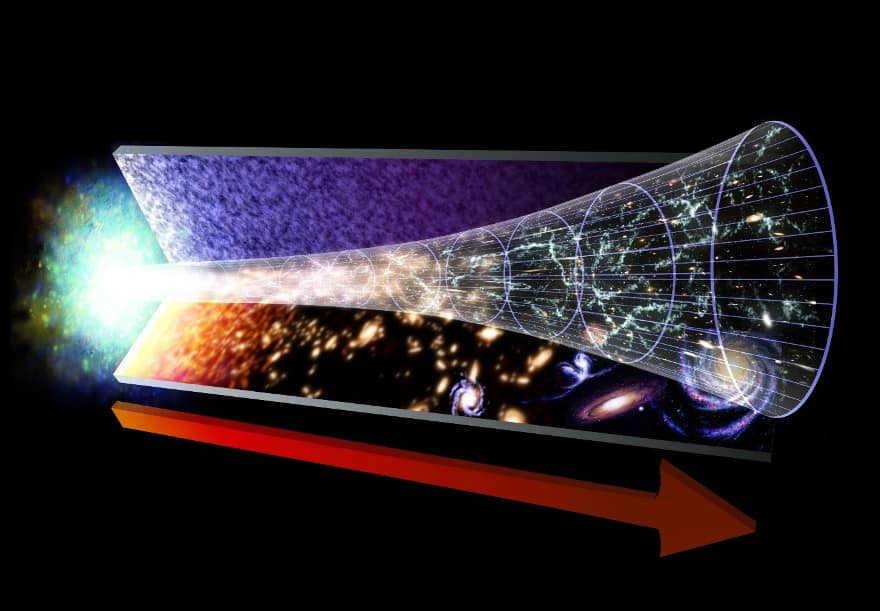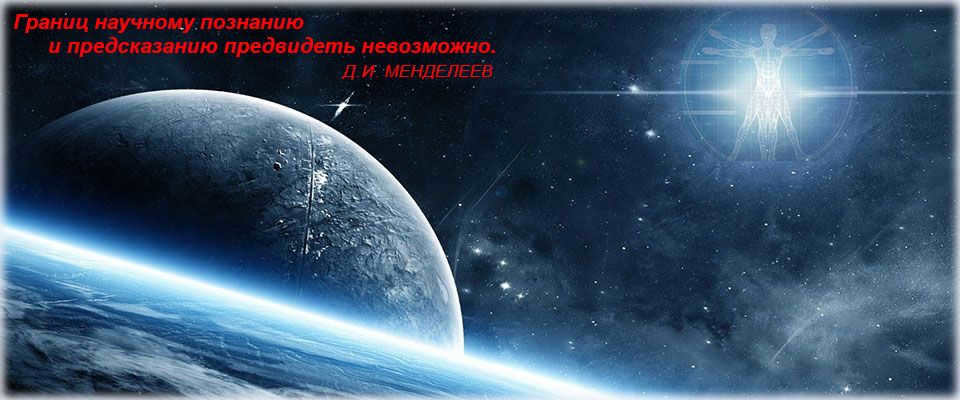

- Homepage
- Galactic Systems
Galactic Systems
Galactic systems are collections of stars, star clusters, interstellar gas and dust, and dark matter that are held together by gravity. In relation to the planet Earth, these objects are incredibly far away. The observable part of the universe contains approximately one hundred billion of these systems. Their sizes range from 10 7 to 10 12 times the mass of the Sun, while our own Milky Way galaxy has a mass of 2-10 11 times that of the Sun.
Galaxies consist of stars, star clusters, interstellar gas and dust, as well as dark matter, all held together by gravity.
All components of a galaxy are in motion relative to a central point. The outer regions of galaxies can rotate at speeds ranging from 50 to 300 km/s, with rotation periods spanning from one million to one billion years. In our Milky Way galaxy, the Sun and its planets move around the center at a velocity of 220-240 km/s, completing one orbit approximately every 200 million years.
Galaxies come in a wide variety of forms, including disk spiral galaxies, spherical elliptical galaxies, barred galaxies, lenticular galaxies, dwarf galaxies, irregular galaxies, and more.
Spiral galaxies typically consist of a disk, arms, a central elliptical bulge (a dense collection of stars), and a spherical halo that is similar in size to the disk. The majority of stars in the halo are found in globular clusters. A significant number (approximately two-thirds) of spiral galaxies have a central bar, with spiral arms extending from its ends. It is not uncommon for the nucleus of a galaxy to contain a supermassive black hole.
Diagram illustrating the structure of a spiral galaxy
The arrangement of globular clusters located at the center of galaxies remains unaffected by the position of the galaxy’s disk. The spiral arms of galaxies, while housing only a small proportion of all stars, are home to a majority of hot, highly luminous stars. These stars are typically considered young by astronomers, suggesting that the spiral arms of galaxies serve as a site for the formation of new stars.
We reside within a spiral galaxy known as the Milky Way, and during clear skies, our Galaxy appears as a broad whitish band spanning across the night sky. We are able to observe our Galaxy from a side view.
Elliptical galaxies possess a distinct spherical (ellipsoidal) structure with diminishing brightness towards the outer regions. The rotation speed of ellipsoidal galaxies is slower compared to spiral galaxies, resulting in the absence of a disk formation. The occurrence of new star formations in elliptical galaxies is nearly non-existent. Typically, such galaxies contain an abundance of globular star clusters.
Lenticular galaxies serve as an intermediate type between spiral and elliptical galaxies. They exhibit a halo and a disk, but lack spiral arms. The majority of their composition comprises aging stars. These galaxies are designated as S0.
Irregular galaxies are typically characterized by a disordered form without a clear central core or spiral arms. They constitute approximately 25% of all galaxies. Many irregular galaxies were once spiral or elliptical in shape, but have undergone distortion due to gravitational influences.
Galaxies are not uniformly distributed throughout observable space, but instead tend to cluster together in gravitationally bound groups or clusters.
Galaxy clusters are the most prevalent and compact structures in the cosmos (accounting for approximately 95% of them), consisting of several dozen galaxies. They are frequently governed by a solitary massive elliptical or spiral galaxy, which gradually absorbs satellite galaxies and grows in mass due to tidal forces. Within these clusters, the velocities of galaxies moving away from each other, induced by the Hubble expansion of the universe, are relatively weak, with random peculiar velocities prevailing. A single galaxy can possess a velocity exceeding 1000 km/s in an arbitrary direction.
Our Galaxy, along with the Andromeda galaxy, dominates the Local Group, which consists of more than 40 galaxies spanning about 1 megaparsec. The Local Group is a part of the Virgo supergroup, where the Virgo cluster plays a significant role, although our galaxy is not included in it.
With the naked eye, only three galaxies are visible in the sky: the Andromeda Nebula (visible in the northern hemisphere) and the Large and Small Magellanic Clouds (visible in the southern hemisphere), which are satellites of our Galaxy.
A mega cluster – the biggest kind of galaxy cluster, consists of thousands of galaxies. The configuration of these clusters can range from chains, like the Markarian chain, to walls, like Sloan’s great wall. On the scale of supercollisions, galaxies align themselves in filaments encircling vast, sparsely populated voids and creating planar clusters.
Illustration of cosmic filaments
Chart of galaxy clusters and empty regions
One of the unresolved mysteries in comprehending the composition of galaxies is the alleged existence of dark matter within them, which is only evident through gravitational interaction. It can account for up to 90% of the overall mass of the galaxy and could potentially be entirely absent, as observed in certain dwarf galaxies.
Video: The Vastness of the Universe and the Fascinating Array of Alien Galaxies

The majority of our Galaxy consists of stars, interstellar gas, and cosmic rays. These components are held together by gravitational and magnetic fields. Additionally, there are various forms of electromagnetic radiation, such as radio waves, light, X-rays, and gamma rays, which play a vital role in the existence of individual stars but have minimal impact on the overall system. Stars account for 90-95 percent of the Galaxy’s matter, with the remaining portion primarily consisting of gas, predominantly hydrogen.
The shape of the galaxy is more reminiscent of a circular saw than a frisbee. You and I reside approximately 30,000 light-years away from the galactic center, positioned along the outer rim of the disk, but still relatively close to its central plane.
When viewed from the side, the galaxy appears as a flat disk with a dense bulge at the center. However, a full-face view reveals a more intricate structure.
The galaxy’s gas nebulae are arranged in luminous bands, forming spiral arms. Our Sun is situated near the outer edge of one of these arms, known as the Solar arm or Swan-Kiel arm. As we move further away from the Sun, towards the outskirts of the galaxy, we encounter the Perseus arm, which becomes discernible at a distance of 9000 light-years. And if we venture 4000 light-years closer to the galactic center, we can observe the Sagittarius arm.
Let’s consider what is even closer to the center and what is located behind it, we cannot interfere with the “black bags” of cosmic dust.
Indeed, some clarity came with the development of radio astronomy. Cosmic dust proved to be quite transparent to radio waves. Neutral hydrogen emits decimeter radio waves intensely. Based on this radiation, it has been established that in the space between the arms, one hydrogen atom falls on 5 cubic centimeters, and in the arms, the average density of the gas is five times higher.
Radio observations have convinced astronomers that our vast stellar abode consists of 10-14 spiral floors. We now have a clear idea of what it looks like in plan and section. There is only one thing that remains unclear… why it has not collapsed a long time ago.
The smudging of the spirals is required
The formation of the galaxy is characterized by its intricate structure and its rotation around its central point. The curved nature of the spiral arms of the galaxy follows a precise mathematical pattern known as the logarithmic spiral. The curvature of the arms in numerous other spiral galaxies also adheres to this stable shape, which has been present for billions of years, possibly predating the formation of our own solar system. However, it is at this point that the inexplicable phenomena emerge.
It is a reasonable assumption that each star, gas molecule, or speck of dust rotates independently around the center of gravity of the Galaxy, similar to how artificial satellites move around the Earth. However, if this were the case, the masses of galactic matter closer to the center of the Galaxy would complete a revolution much faster than those further away. For instance, while it would take our Sun “only” 200 million years to complete one revolution, some inhabitants of the Galaxy closer to the center would overtake it, while those further away would lag behind. This would cause the arms of the Galaxy to either smear into a solid disk or break into concentric rings, similar to Saturn’s rings. Until recently, astronomers could not understand why this did not occur.
The stability of the spiral arms in the galaxy is a perplexing and astonishing phenomenon. The situation worsens when considering the center of the Galaxy, where the gas density is significantly higher compared to the arms. It appears that this dense gas somehow “escapes” into the arms. The nearest spiral arm to the center alone should expel a mass of gas equivalent to that of the Sun every year, according to the renowned Dutch astronomer Oort. In a mere thirty million years, this single arm should have completely depleted the gas from a disk spanning up to 9,000 light-years in radius. This process seems excessively rapid!
One possible explanation for the prolonged existence of the galactic nucleus is the influx of new gas from an unidentified source. However, no such source has been discovered thus far.
In an unprecedented breakthrough, Professor G. Richter from Germany has made a compelling effort to elucidate the enduring form of the Galaxy.
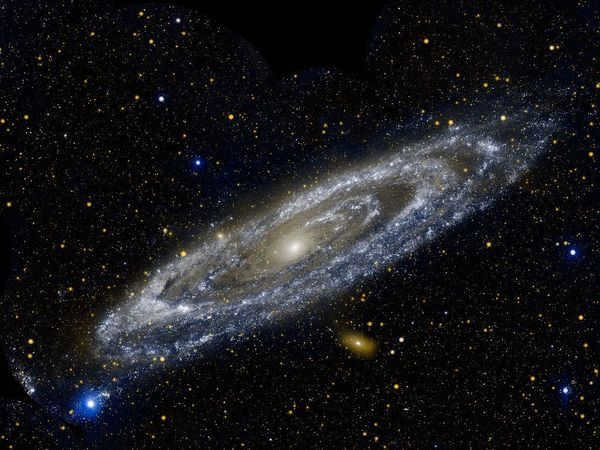
The shock wave shapes the galaxy
As a preliminary measure, Richter meticulously examined the arrangement of neutral hydrogen within the Galaxy. He made a startling discovery: the gas density in the spiral arms is not uniform. In certain regions, the radio telescope detected peaks of radiation followed by valleys. This evidently corresponds to the compression and rarefaction of interstellar gas.
Thickening and rarefaction! But how and why did they come about? There is an illustration in a physics children’s book: a bell, accompanied by an ear, with thicker and then sparser dots in between. This demonstrates the characteristics of a sound wave. The bell’s oscillation compresses the adjacent layer of air, which then elastically expands and compresses the neighboring layer, and so on. This creates a wave in the air consisting of compression and rarefaction.
If some form of wave were to propagate through the interstellar gas, thickening and rarefaction along the arms of the Galaxy could occur. The wave nature of galactic spirals had not been considered before Richter. However, in the meantime.
No matter how rarefied the gas is in interstellar space, no matter how far apart its atoms are, and no matter how infrequent their collisions, it still behaves like a gas and follows the typical gas laws. Even in this sparsely populated interstellar gas, sound waves travel at approximately one kilometer per second, which is only three times faster than in air that has a much higher density. However, it was not sound waves that Richter discovered in the interstellar gas.
Sound waves cause particles to oscillate while remaining in place. This is not the case with shock waves or blast waves that travel at supersonic speeds. These waves involve alternating regions of compression and rarefaction. In a shock wave, the compressed mass of gas is also moving, and it moves at an incredibly high speed.
A visual representation of a shock wave would resemble a snapshot of a projectile slicing through the atmosphere. And just like a projectile, the shock wave exhibits similar behavior: at its front, the flexible gas, which often goes unnoticed, gets compressed and takes on a solid-like state, making it difficult for obstacles to withstand its force. Shock waves in the atmosphere are responsible for the sonic boom produced by supersonic jet airplanes as well as the destructive power of dynamite explosions. Additionally, shock waves can also be observed in the gas found in interstellar space.
Let us unravel the enigma of the steadfastness of our celestial abode with a tangible illustration. Situated at a distance of 10 thousand light years from the nucleus of the Galaxy, approximately midway between its core and the Sun, lies a spiral arm that is receding from the core at an unusually rapid pace – clocking in at an astounding 53 kilometers per second. On the opposite side of the nucleus, there is another arm that is fleeing even more swiftly. The remaining arms also exhibit movement away from the nucleus, albeit at a considerably more leisurely pace.
Let’s focus on another interesting fact: both runaway arms, along with the entire Galaxy, revolve around the center at a slower pace than what is needed to maintain the Galaxy’s integrity. In stable systems, as they rotate, the centrifugal force of inertia should be counterbalanced by gravity – the force that pulls objects towards the center of mass. However, the centrifugal force increases with higher rotation speeds. If the rotation speed is too slow, objects fall towards the center, and if it is too fast, they move away from it. The rotation speed of the distant branches is noticeably lower than what is required for the equilibrium between centrifugal force and attraction. Nevertheless, these branches not only fall towards the galactic center, but actually move away from it. Why does this happen?
The heart of the Milky Way
Richter unraveled the enigma residing at the heart of our galaxy. The cluster of celestial bodies in this region surpasses the density surrounding our Sun by a factor of a thousand. Nestled within the core lies Sagittarius A, a potent source of radio waves resembling a colossal sphere spanning a distance of 500 light-years. Enveloping this sphere, a swiftly spinning gas disk with a distinct outer boundary stretches out 2500 light-years from the center. Remarkably, this gossamer-like gas disk rotates akin to a solid entity, in contrast to a hazy nebula of gas.
At first sight, this phenomenon may appear peculiar. How is it possible for a gas to transform into a solid state? The explanation lies in the following: the edges of the disk rotate at an incredibly high linear velocity of approximately 260 kilometers per second, causing the gas particles to behave as if they are confined within solid boundaries. (Analogous to the experience of diving into water from a great height, one can observe how the otherwise pliable and soft medium becomes rigid when moving at excessive speeds).
Now, taking into account our previous discussion regarding the potential existence of shock waves within galactic gas, we can easily comprehend the crux of Richter’s concept.
Professor Richter states that the shock wave’s initial velocity is approximately 60 kilometers per second. As it moves through the interstellar gas, it remains inside a “solid tube” created by the rotating disk within the “solid walls”. However, the shock wave’s speed decreases as it moves away from the center due to resistance from the interstellar medium and gravitational influences, causing its path to curve. Eventually, the wave dissipates, but this process takes billions of years because the trajectories and paths of wave propagation in the gas are highly stable.
This also explains why the central galactic disk has not yet been depleted. In a shock wave, densification is followed by rarefaction, allowing some of the matter to return to its original position.
According to Richter, the spiral arms of the Galaxy are actually shock waves that occasionally emerge in its central region. These cosmic shock waves have a massive cross-section, measuring millions of square light years. Richter determined that the time intervals between successive shock waves are approximately 300 to 400 million years, based on the thickening and thinning observed in the arms. The most recent shock wave occurred roughly 60 million years ago.
This means that our stellar abode takes on a new appearance – instead of being a loose, hazy formation, it now resembles a rapidly spinning cloud of gas and stars. This structure is held together and shaped by enormous waves, giving it a complex and delicate dynamic.
Waves, stars, life
These days, scientists frequently surpass logical deductions and permit themselves semi-fantastic speculations. Whether the suppositions are validated or not – it doesn’t impact the core of the fundamental hypothesis, but daring comparisons and analogies can act as a catalyst for intriguing contemplations.
It is fascinating to become acquainted with the deliberations of Prof. Richter regarding the origins of… the demise of dinosaurs.
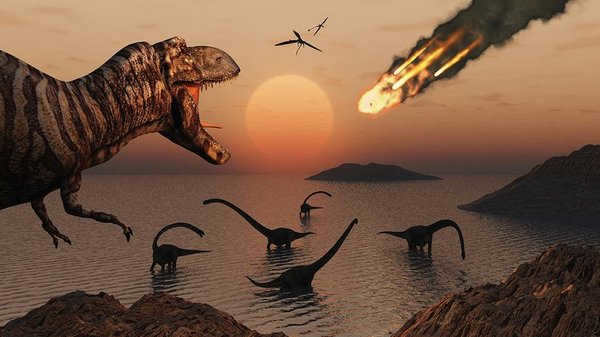
Various theories have been suggested to explain the extinction of these giants, which paved the way for the rise of mammals as the dominant species on Earth 60 million years ago. This significant biological shift has been attributed to cosmic disasters, epidemics, global cooling caused by shifts in the planet’s poles, and other yet to be understood processes occurring on the Sun.
Richter observed that the timing of the last shock wave in interstellar gas coincided with the extinction of the dinosaurs. He also compared other sudden shifts in Earth’s history with the intervals between cosmic shock waves. From this, he concluded that these shock waves could have had a significant impact on all forms of life. However, Richter couldn’t provide any specifics about how exactly this hypothetical influence would occur.
Now, here’s another semi-fantastic hypothesis. It relates to a more broad issue – the birth of stars.
According to Richter, the density of gas in front of a shock wave would temporarily increase by hundreds or even thousands of times. This would create conditions favorable for the condensation of matter into dense cosmic bodies.
Imagining the dispersion of matter in space is relatively simple: gas tends to occupy a larger volume, causing its particles to scatter in all directions. Additionally, a gas cloud that lacks significant internal gravitational forces will be pulled apart by the gravitational force towards the center of the Galaxy.
However, if a shock wave causes the cloud to contract, the gravitational forces within it will increase significantly. These forces could keep the particles together, allowing the cloud to thicken and potentially become a star.
Naturally, this is only a hypothesis, and even a somewhat fantastical one at that, but it is highly intriguing to astronomers.
Authors: S. Vladimirov, M. Karev.
Once people understood the vastness of our universe, they came to the realization that the Earth is not the focal point of the universe. The understanding that even the immense solar system does not encompass the entirety of the cosmos sparked the imagination. It became evident that all the stars we can observe are just a small fraction of the immense structure known as a galaxy.
A galaxy is a colossal celestial assemblage of stars, gas, and dust that are bound together by gravitational forces. All the components of a galaxy revolve around a shared center of mass, typically a massive nucleus that is centered around a black hole.
Thanks to the Hubble telescope, astronomers have been able to observe distant galaxies. There are at least 100 billion galaxies in the observable part of the Universe! They are scattered in a random manner – some areas have dense clusters of galaxies, while others are completely empty. The masses of these galaxies can range from 10^7 to 10^12 times the mass of our Sun. In terms of size, they can have diameters ranging from 16,000 to 800,000 light years.
Galactic associations and the composition of galaxies
Galaxies consist of a combination of three main elements:
- Dark Matter, which constitutes the majority of the mass
- Interstellar gas and dust, accounting for approximately 10 – 30%.
- Stars, black holes, neutron stars, planets, asteroids, and other small objects make up about 1% of the total mass
Around 95% of galaxies are found in clusters. These clusters can vary in size, with small clusters containing only a few dozen objects, while larger clusters can consist of tens of thousands. Furthermore, clusters themselves can be grouped into even larger structures known as superclusters, which can contain thousands of galaxies.
Organization
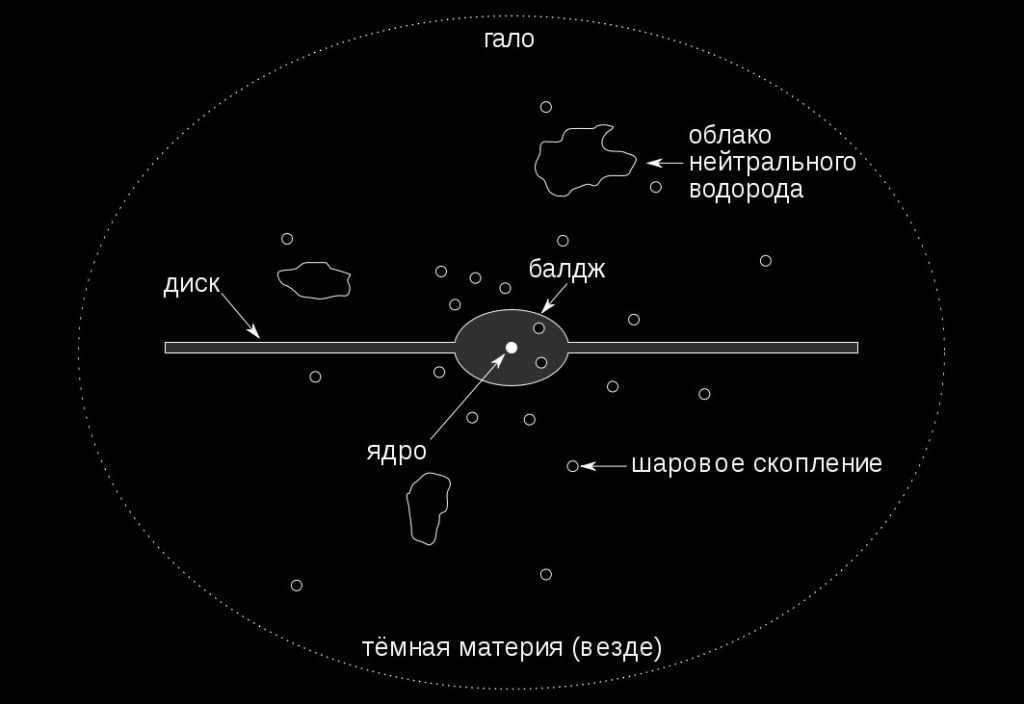
- Nucleus. Typically refers to active nuclei located at the very core. The cores of galaxies harbor massive black holes.
- Disc. Within this thin layer, the largest concentration of galactic objects (stars, gas, dust) is found.
- Bulge. This is the luminous inner region at the center. It literally means “swelling”.
- Halo. It is the outer spheroidal component. There is no distinct boundary between it and the bulge.
- Spiral arm. Represents a dense structure composed of young stars and interstellar gas.
- Bar. An elongated dense structure that acts as an intermediate layer. Composed of interstellar gas and stars.
Various Kinds of Galaxies
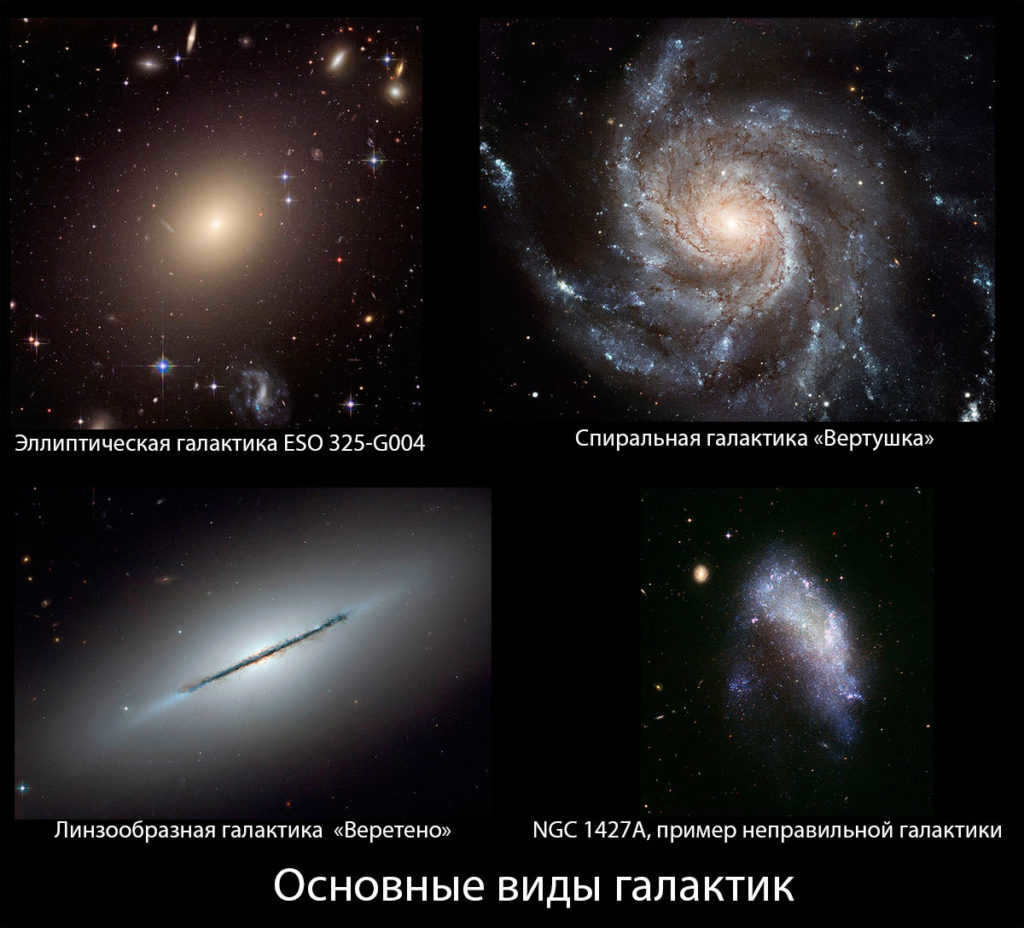
- Elliptical. Galaxies of this type lack a disk component or have a minimal contrast.
- Spiral. These galaxies are characterized by spiral branches, sometimes appearing as rings.
- Lens-shaped. These galaxies are similar to spiral galaxies but lack distinct spiral arms. They have a low percentage of interstellar gas, resulting in a low rate of new star formation.
- Irregular. These galaxies have a wispy and tattered structure. They contain a significant amount of interstellar gas, up to 50%.
Interactions Between Galaxies
Interactions between galaxies are a common occurrence in the vast expanse of the Universe. It is highly probable that our very own Milky Way underwent a similar event approximately 2 billion years in the past. Due to the immense distances between celestial bodies, only a fraction of the stars actually collide upon contact. Galaxies possess varying velocities, resulting in unique outcomes during the collision process. Frequently, these interactions lead to a merging of galaxies or a passing through one another.
There are two distinct explanations for the origin of galaxies:
- Formation from small objects. Initially, regions of non-uniform matter with a mass of approximately 1 million solar masses were created. Over time, these regions merged and formed larger structures, accumulating the mass of hundreds of billions of stars. Subsequently, galaxies combined to form groups and clusters.
- Formation from large objects. Following the Big Bang, there was a significant expansion in space, causing the stretching of massive structures. This stretching resulted in the formation of dense matter “sheets” which gave rise to globular clusters.
Studying Galaxies: An Exploration
In 1755, the brilliant mind of Kant predicted the existence of galaxies, envisioning them as vast collections of rotating stars. This hypothesis was later confirmed by Herschel in 1780 through a meticulous calculation of visible celestial bodies. Building upon these observations, Herschel was able to construct a comprehensive three-dimensional model of the Milky Way.
In 1936, E. Hubble revolutionized our understanding of galaxies with his classification system, which remains in use today. Additionally, Hubble made groundbreaking progress in determining the distance to the Andromeda Nebula, albeit with some margin of error. Most importantly, his work revealed that the Universe extends far beyond the confines of our own Milky Way.
By utilizing the phenomenon of the Doppler effect (or more specifically, the redshift it produces) in the spectral analysis of galaxies, scientists have determined that all observed galaxies, with the exception of those closest to us, are moving away from our location.
Furthermore, it has been observed that the speed of a galaxy’s movement is directly proportional to its distance from us. This leads to the logical conclusion that in the distant future, galaxies and stars that are currently observable will gradually disappear from our view, as the light emitted from them will no longer reach us. Eventually, our own galaxy will merge with the Andromeda Nebula.
In the universe, there are various systems formed by stars that coexist within a shared gravitational field for extended periods. Many stars are part of double or multiple systems, where the components revolve around a central point similar to the planets in our solar system. Among these systems, star clusters and associations are particularly noteworthy. Star clusters can consist of millions of stars, as depicted in Figure 15.1. On the other hand, scattered star clusters typically have thousands of objects, with the Pleiades (Stozhars; Figure 14.2) and the Hyades being the most prominent examples visible to the naked eye in the constellation Taurus. Moreover, stellar associations are composed of relatively young stars that originated from a common source.
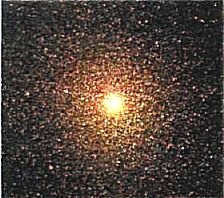
Fig. 15.1. A globular star cluster located in the Hercules constellation: it is estimated to be 16,000 light-years away and has a diameter of 75 light-years. It contains approximately one million stars.
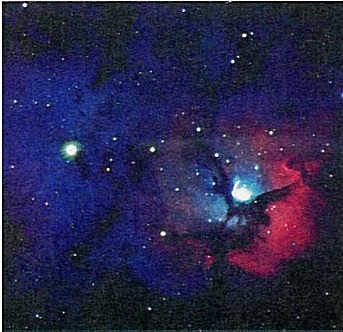
Fig. 15.2: Trifid gas-dust nebula in the Sagittarius constellation
The flat component of the Galaxy, which includes the Solar System (Fig. 15.3), is comprised of all these objects. Stars of low luminosity that are part of globular clusters and are older belong to the spherical component of the Galaxy. In terms of chemical composition, the stars of globular clusters have significantly fewer heavy chemical elements than the Sun because they are first-generation stars that formed at the same time as the Galaxy, 10-15 billion years ago. The formation of new stars and planetary systems now only occurs in the Galaxy plane, where gas-dust nebulae are created following the explosion of New and Supernovae stars.
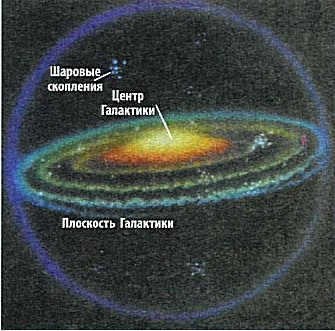
Figure 15.3: Structure of the Galaxy. The plane of the Galaxy contains gas-dust nebulae, which serve as the birthplace of young stars and planetary systems
The Galactic Center
The center of the Galaxy is positioned towards the constellation Sagittarius, but it is obscured from our view by extensive dust clouds that absorb visible spectrum radiation (Fig. 15.4). Within the Galactic center lies a nucleus with a diameter of 1000-2000 pc. It is hypothesized that the Galactic center harbors a black hole with a mass millions of times greater than that of the Sun.
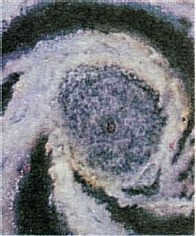
Figure 15.4: The central region of the galaxy as viewed from the Sagittarius constellation
Located at the heart of the galaxy, near the nucleus, lies a peculiar bulge – a rounded protrusion that is home to a concentration of stars and hot gas clouds. These celestial bodies are situated at a distance of approximately 10,000 parsecs from our location. Enveloping the galaxy’s center, these clouds create a thick shroud that prevents direct optical observation of the nucleus using telescopes. However, the intense radiation emitted by the central region (nucleus) can be detected using radio, infrared, and X-ray telescopes.
Stars’ Rotation in the Milky Way
The Sun is positioned at a distance of 25000 sv. years from the core of the Galaxy, near the Galactic plane. Its velocity vector is directed towards the constellation Hercules in relation to the nearest stars. Along with its neighboring stars, the Sun orbits the galactic nucleus at a speed of 250 km/s. The galactic year, which is the period of the Sun’s orbit around the nucleus, lasts for 250,000,000 Earth years. The analysis of the orbital velocity of stars reveals a significant difference in the behavior of objects in the spherical and flat components of the Galaxy. While the stars in the flat component orbit around the Galaxy’s center in a single plane, the stars in the spherical component form large globular clusters that orbit in elongated paths in various planes. Moreover, the rotation period of these clusters indicates that a substantial amount of mass in the Galaxy is distributed in the spherical component. This mass could consist of low-mass objects that do not emit visible light, or low-mass black holes (Fig. 15.5).

Fig. 15.5: The rotation of stars in the Galaxy
One of the enigmas of the Galaxy lies in the spiral arms that emerge from its core. The Sun is positioned on the edge of one such arm, which is twisted within the galactic disk plane. Scientists speculate that spiral arms are the result of spiral density waves that form when interstellar gas clouds undergo compression during the initial phase of star creation (see §14). This star formation process generates shock waves within interstellar gas and dust clouds, leading to the birth of young stars. When massive stars explode as Supernovae, new nebulae and shock waves are produced and travel through interstellar space. Thus, the birth of one cluster of stars serves as a catalyst for the creation of a new generation of stars. This phenomenon is sometimes referred to as self-propagating star formation.
The nearest neighbors of our galaxy
During the examination of other galaxies, astronomers have made an observation that not all of them possess a spiral structure. There are three classifications of galaxies – spiral, elliptical, and irregular. Our Galaxy, as well as the galaxy M31 in the constellation Andromeda, are classified as spiral galaxies. They share a similar appearance, nearly the same size, and approximately the same number of stars. The galaxy M31 is situated at a distance of 2 million light-years from Earth – it is the most distant object in the Universe that can still be observed with the unaided eye (Fig. 15.6). The nearest galaxies to us, the Large and Small Magellanic Clouds (LMC, SMC), can be observed in the southern hemisphere sky.
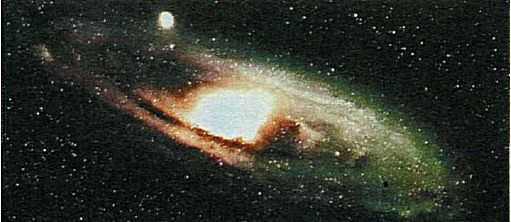
Figure 15.6. The Andromeda galaxy, also known as Galaxy M31, is visible to the naked eye. It is located approximately 2.3 million light-years away.
Within the spiral arms of galaxies, there is currently a significant occurrence of young star formation and the creation of planetary systems. In contrast, elliptical galaxies are composed mostly of old yellow and red stars. It is possible that the star formation process has already ceased in these elliptical galaxies.
The arrangement of galaxies in the Universe
- Planetary systems and their moons revolving around their respective stars.
- Assemblages of stars known as star clusters, which can contain thousands or even millions of individual objects.
- Aggregations of hundreds of billions of stars orbiting a central nucleus, forming galaxies.
- Gatherings of millions of objects known as galaxy clusters.
Our own Milky Way and the M31 galaxy are part of the Local Group of galaxies. The largest concentrations of galaxy clusters are found in the constellations of Virgo and Coma Berenices (Figure 15.7). In these regions, astronomers have identified a structure known as the Great Wall, where the number of galaxies significantly increases compared to other areas, at a distance of 500 million light-years.
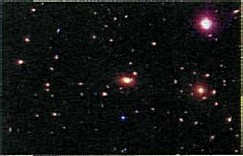
Fig. 15.7: Cluster of galaxies in the constellation Veronica’s Hair
In the constellation Veronica’s Hair, a cluster of galaxies can be observed where individual galaxies interact with each other. These interactions sometimes result in collisions, leading to a phenomenon known as galactic “cannibalism” (Fig. 15.8). In the fourth and final stage of hierarchical structure, galaxy clusters exhibit minimal interaction, with no common center around which millions of galaxies orbit.
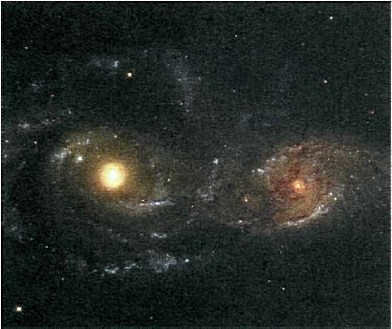
Figure 15.8: Galaxy collisions
Another distinctive characteristic of the spatial distribution of galaxies is that they are not randomly placed in the Universe on a large scale, but instead form intricate structures resembling vast networks of fibers. These fibrous networks encircle enormous, relatively empty regions known as voids. Some of these voids have a diameter of 300 million light years. One plausible explanation for the fibrous structure of the Universe is that galaxies are situated on the surface of immense bubbles, with the voids representing their inner regions. To observers on Earth, it appears as if the galaxies are arranged like necklaces strung on fibers, as we see them on the outer surfaces of these immense cosmic bubbles (Fig. 15.9).
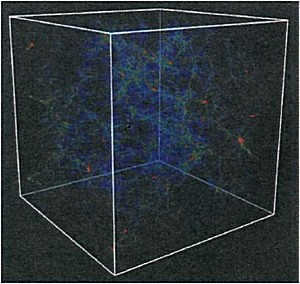
Figure 15.9: The arrangement of matter in the cosmos resembles a network of interconnected fibers. These fibers form enormous bubbles, which contain galaxies. To us, these galaxies appear like a string of pearls, creating a beautiful cosmic necklace.
| The Great Wall – a colossal assemblage of galaxy clusters located in the direction of the Virgo and Coma Berenices constellations |
Hubble’s Law
In 1929, E. Hubble, an American astronomer, examined the spectra of galaxies and observed a redshift in the absorption lines of all the spectra. This redshift indicates that all galaxies are moving away from us, as predicted by the Doppler effect. Furthermore, the amount of displacement in the spectral lines can be used to calculate the velocity at which these galaxies are receding. It was discovered that the velocity at which other galaxies are moving away from us is directly proportional to their distance (Hubble’s law): V = Hg, where V represents the velocity of the galaxy, H is Hubble’s constant, and r is the distance to the galaxy in megaparsecs. Recent measurements suggest that H is approximately equal to 70 km/(s.Mpc).
| The galaxies are moving away from each other – The incredible phenomenon of the Universe’s expansion, which is characterized by the increasing separation between galaxies |
For those who are interested.
According to Hubble’s Law, if we know the shift of spectral lines, we can calculate the velocity of a galaxy and, consequently, its distance. The farthest object that has been observed is located at a distance of 14 billion light years and has a velocity of 280,000 km/s. This means that we are seeing it at a time when not only our Earth and Sun, but even our Galaxy did not yet exist. At first glance, it may appear that our Galaxy is at the center of this expansion, but it turns out that the Universe has no center. An observer from any other galaxy would see the same expansion, leading them to believe that their galaxy is also at the center of the Universe.
Models of the Universe
In order to create a unique model of the universe, we must address the inquiry, “Does the universe possess any spatial boundaries?”. With its infinite expanse and boundless existence in both space and time, the universe captivates our attention with its lack of edges and its infinite number of stars and galaxies. However, within this eternal and infinite cosmos, conflicts arise that are referred to as cosmological paradoxes within the field of astronomy. These paradoxes include the photometric paradox, the gravitational paradox, and the “warm death” of the universe.

Figure 15.10: Imagine a one-dimensional world that is boundless but has a finite length. This world can be represented by a circle, where you can travel around and come back to the starting point.
On the other hand, a two-dimensional space without boundaries can be represented by the surface of a sphere. Although it has no edges, the surface area of the sphere is still a finite quantity (Fig. 15.11).

Figure 15.11: A two-dimensional boundless world with a finite area can be represented by a sphere. It is possible to travel around the globe in this space, as Magellan demonstrated to prove that the Earth’s surface is limitless.
We inhabit a three-dimensional realm, making it challenging to envision a closed Universe devoid of boundaries, yet possessing a finite volume and therefore a limited number of stars and galaxies. Within such a Universe, no point holds superiority, as all are equal, and space exhibits homogeneity in every direction. In practical terms, determining the nature of a being’s dwelling or ascertaining the finiteness of space proves arduous. If space is indeed finite, a traveler venturing forth in a single direction can complete a circumnavigation and arrive back at the starting point. In the annals of Earth’s civilization, the first individual to accomplish such a journey was Magellan (1480-1521), who demonstrated that the Earth’s surface constitutes a closed two-dimensional expanse.
In a three-dimensional Universe, astronauts will never be able to complete such a round-the-world trip, so the verification can only be done through theoretical reasoning, which we will discuss in the following paragraph.
Conclusions
The Universe possesses a complex cellular structure where the gravitational interaction of all celestial bodies occurs. Stars and planets revolve around stars, and stars form massive clusters consisting of hundreds of thousands and millions of objects. Within the shared gravitational field of galaxies, there are already hundreds of billions of stars that orbit around a common center. Galaxies also form distinct clusters, which are not randomly placed on a large scale but instead create peculiar structures resembling vast networks of fibers. We inhabit an expanding universe that stretches infinitely into space.
- The Greek translation of the word “galaxy” means:
- A. Milky Way.
- B. The silvery path.
- C. The black path.
- D. The big road.
- E. Chumatsky Shlyakh.
- What is located at the center of the Galaxy?
- A. A star cluster.
- B. A black hole.
- C. A red giant.
- D. A white dwarf.
- E. A black cloud.
- The galactic year is determined by:
- A. The period of rotation of the Galaxy around its axis.
- B. The period of the Sun’s revolution around the center of the Galaxy.
- C. The distance light travels to a galaxy in the constellation Andromeda.
- D. The period of revolution of the Galaxy around the center of the world.
- E. The period of spherical rotation of stars around the center of the Galaxy.
- The term “Great Wall” in astronomy refers to:
- As per Hubble’s Law, all galaxies are expanding in different directions. What lies at the center of this expansion?
- A. Earth.
B. Our Milky Way galaxy.
C. The galaxy M31 in the Andromeda constellation.
D. A galaxy cluster in the Virgo constellation.
E. There is no center, as the infinite Universe has no center or edges.
- A. Earth.
- Which stars are part of the galactic plane component?
- What are the different structures found within galaxies?
- What is the method for using Hubble’s Law to determine the distance to galaxies?
- Is it possible for galaxies to collide?
- If light from a galaxy travels 4.108 light-years to reach Earth, how can we calculate its velocity away from us?
- How can the photometric paradox of a never-ending and infinite Universe be explained: “If the Universe is infinite, why is it dark at night?”
- Which constellations does the Milky Way pass through?
- In which direction is the center of the Galaxy located? What time does the center of the Galaxy rise and set on the day of your birth?
- Where can the Andromeda Nebula (a galaxy in the constellation Andromeda) be found in the sky? During which time of year is this galaxy visible throughout the night?
Stellar matter, which constitutes the majority of the mass and dust, accounting for approximately 70-90%.
Interstellar matter, which includes gases, black holes, neutron stars, planets, asteroids, and other small entities, making up around 1% of the total mass.
Dark matter, a mysterious substance that has not yet been fully understood by scientists, but is estimated to account for approximately 10-30% of the mass.
A. The source of new stars and planetary systems.
B. A massive galaxy cluster located in the direction of the Virgo and Coma Berenices constellations.
C. The protective formations that cosmic civilizations have constructed.
D. A conglomerate of gas and dust found in the vast expanse between galaxies.Key concepts and terms:
The Great Wall, galactic core, galactic orbital period, stellar conglomerates, galaxy dispersion, spiral-shaped galaxies, Hubble’s constant.
A galaxy is an enormous system consisting of billions of stars and their conglomerates, gas, dust, magnetic field, and cosmic rays.
Categories of galaxies: elliptical, spiral, irregular.
Active galaxies are galaxies in which there is a phase of rapid evolutionary processes accompanied by the formation of new structures and increased radiation in all ranges.
Radio galaxies are galaxies whose radio emission power becomes comparable to or even greater than the optical one.
Quasar refers to a galaxy’s core with radiation power billions of times greater than the luminosity of the sun.
Redshift in the spectra of galaxies is the phenomenon in which the light spectra of galaxies shift towards the red end of the spectrum.
Hubble’s Law states that the speed at which galaxies are moving away from us is directly proportional to the distance between us and the galaxies.
Primary and supplementary literature related to the lesson:
1. G.Y. Myakishev, B.B. Bukhovtsev, V.M. Charugin. Physics. 11th grade. Textbook for educational institutions. M.: Prosveshchenie, 2017. pp. 366-373
2. A.S. Labuzov. Observation of galaxies, nebulae, and star clusters. M.: Fizmatlit. 1993.
3. E.V. Lukasheva, N.I. Chistyakova, USE 2018. Typical exam tasks by USE developers.
Key points of the lesson:
When observing the night sky, people have long noticed a hazy band of light stretching across it. This band is commonly known as the Milky Way, named after the Greek mythological story. The ancient Greek philosopher Democritus speculated that the Milky Way was composed of countless distant stars.
When Galileo first observed the Milky Way through a telescope, he made a groundbreaking discovery. He found that the Milky Way is filled with an immense number of small stars. Another astronomer, Herschel, also made a significant contribution to the study of the Milky Way. He determined that our Solar System is located within the Milky Way.
During observations of the night sky, astronomers have come across numerous star clusters and clouds of gas and dust. Upon further analysis, it was revealed that most of these star clusters exist outside of our own Galaxy. To this day, billions of galaxies similar to the Milky Way have been discovered.
All galaxies can be classified into three distinct categories.
An elliptical galaxy is a star cluster that has a spherical or ellipsoidal shape. Around 25% of all galaxies fall into this category. The brightness and density of an elliptical galaxy decrease as you move from the center to the outer edges. The mass of these galaxies can reach up to 10^13 solar masses.
Spiral galaxies make up approximately 70% of all galaxies. They are flat, rotating structures with a central core and branching arms. Some spiral galaxies have a central junction from which the arms extend. These galaxies contain not only numerous stars but also large amounts of gas, dust, and O and B class stars. Our galaxy, as well as the Andromeda galaxy which is the closest to us, are both spiral galaxies. The mass of spiral galaxies can vary from 10^10 to 10^12 solar masses.
Radio galaxies are galaxies whose radio emission exceeds the power of visible radiation.
Active galaxies are a class of galaxies that are currently in an active phase of their evolution, which is accompanied by the ejection of very large amounts of matter from the nucleus. Quasars are a type of active galaxy that is characterized by its high radio emission power. These star-like formations are located in the cores of galaxies. Despite their relatively small size, which is only tens of times the size of the solar system, quasars emit energy (including visible radiation and other types of radiation) at a rate of 10^12 times that of the Sun. To produce such an enormous amount of energy, there must be a source. In the nuclei of galaxies, this source is the gradual capture of nearby stars by a massive black hole, which leads to a reaction that releases a tremendous amount of energy.
Clusters of galaxies exist in addition to individual galaxies. One example is the local group of galaxies, which includes the Milky Way, the Andromeda Galaxy, and the Small and Large Magellanic Clouds. These galaxies are connected by gravity and orbit around a central point of mass. Currently, thousands of galaxy clusters have been discovered, each containing thousands of galaxies.
When analyzing the light spectra of galaxies, it has been observed that all the lines in the spectrum are shifted towards the red end, meaning that the wavelength of these lines increases. The Doppler effect formula suggests that this phenomenon could be attributed to the distance between the light sources and the observation point. In other words, the greater the velocity, the bigger the redshift, and vice versa. Further calculations conducted by E. Hubble have demonstrated that the observed velocity of galaxies moving away is directly proportional to their distance. This can be rephrased as the notion that galaxies are gradually distancing themselves from one another at an increasing pace.
Analysis of training tasks
1. The names of scientists are given in random order.
W. Herschel; Democritus; G. Galileo; Э. Hubble.
Arrange the names of the scientists in chronological order.
Starting with Democritus, let’s place him in first position. He deserves to be at the top in every aspect.
For nearly two thousand years after ancient times, astronomers continued to observe the sky with their naked eyes. It was not until G. Galileo that the first telescope was used. Then, using the most advanced telescope of that era, W. Herschel explored our galaxy, the Milky Way.
And finally, we have E. Hubble, whose groundbreaking discoveries occurred at the beginning of the 20th century.
In summary, the order is as follows: Democritus, G. Galileo, W. Herschel, and E. Hubble.
2. Connect the corresponding elements in the figure.
1. In order to obtain the first pair of elements, we need to remember that the duration of one Earth year, which is the time it takes for the Earth to complete one rotation around the Sun, is 365.25 days.
2. Let’s recall that the Sun has a radius of 700,000km and the speed of points on its equator is 2km/s. Now, we can calculate the time it takes for the Sun (or more specifically, the point on its equator) to complete a full revolution.
3. Therefore, the enormous time frame of 200 million years represents the period it takes for the Sun to orbit around the center of our galaxy.
Upon discovering the vast scale of our universe, humans came to the realization that the Earth is not the center of it all. And once it became apparent that even our massive Solar System is just a small part of a much larger entity – a galaxy – our imaginations were sparked like never before.
A galaxy is a massive assemblage of stars, gas, and dust that are held together by the force of gravity. All the celestial bodies within a galaxy revolve around a central point known as the center of mass. Typically, this center of mass is dominated by a colossal nucleus, which is located around a black hole.
Galactic Associations and the Composition of Galaxies
Galaxies consist of three main components:
- As per Hubble’s Law, all galaxies are expanding in different directions. What lies at the center of this expansion?
About 95% of galaxies are found in clusters. These clusters can range from small groups comprising only a few dozen objects to large groups consisting of tens of thousands. Additionally, clusters themselves can join together to form superclusters, which can encompass thousands of galaxies.

Various Kinds of Galaxies

- Elliptical galaxies lack a disk component or have minimal contrast.
- Spiral galaxies display spiral branches, occasionally manifested in rings.
- Lens-shaped galaxies differ from spiral galaxies solely in the absence of a distinct spiral arm. The proportion of interstellar gas in them is small, resulting in a low rate of new star formation.
- Irregular galaxies possess a wispy, tattered structure and can contain up to 50% interstellar gas.
Galactic Collisions
Collisions between galaxies are a relatively common occurrence in the vast expanse of the Universe. Our own galaxy, the Milky Way, is believed to have undergone a collision approximately 2 billion years ago. Due to the immense distances between celestial objects, it is rare for stars to actually collide when galaxies come into contact. Instead, the collision process typically results in a merger of the two galaxies or a close flyby. The specific outcome of a galactic collision depends on the relative speeds and trajectories of the involved galaxies.
Their Creation
There are two distinct accounts of how galaxies came into existence:
Exploring Galaxies
Back in 1755, the visionary philosopher Immanuel Kant speculated that a galaxy could be comprised of an immense number of stars and have the ability to rotate. This idea was later affirmed by astronomer William Herschel in 1780. Herschel conducted a comprehensive analysis of visible stars and, based on his observations, was able to construct a three-dimensional model of our own galaxy, the Milky Way.
In 1936, astronomer Edwin Hubble classified galaxies using a system that is still in use today. He also managed to estimate the distance to the Andromeda Nebula, albeit with a significant margin of error. However, his most significant discovery was the realization that the Universe extends far beyond our own galaxy.
As the observed object’s distance increases, its velocity also increases. This implies that in the distant future, other galaxies and stars will vanish from our sight because their light will no longer reach us. Eventually, our galaxy will merge with the Andromeda Nebula.

The Milky Way is categorized as a spiral galaxy with distinctive stripes. This galactic structure spans a vast distance of 100,000 to 180,000 light-years. Scientists estimate that it houses an impressive 100 to 400 billion stars, with a probable count of at least 100 billion planets. Positioned within the galaxy’s disk, our solar system is situated approximately 26,490 light-years away from the Galactic center. Specifically, it is located on the inner edge of Orion’s Arm, one of the spiral concentrations of gas and dust. In the central region, stars within the innermost 10,000 light-years form a bulge, accompanied by one or more rods. The galactic center itself is a prominent radio source known as Sagittarius A. This source is believed to be a supermassive black hole with a mass of 4,100 million times that of our sun.
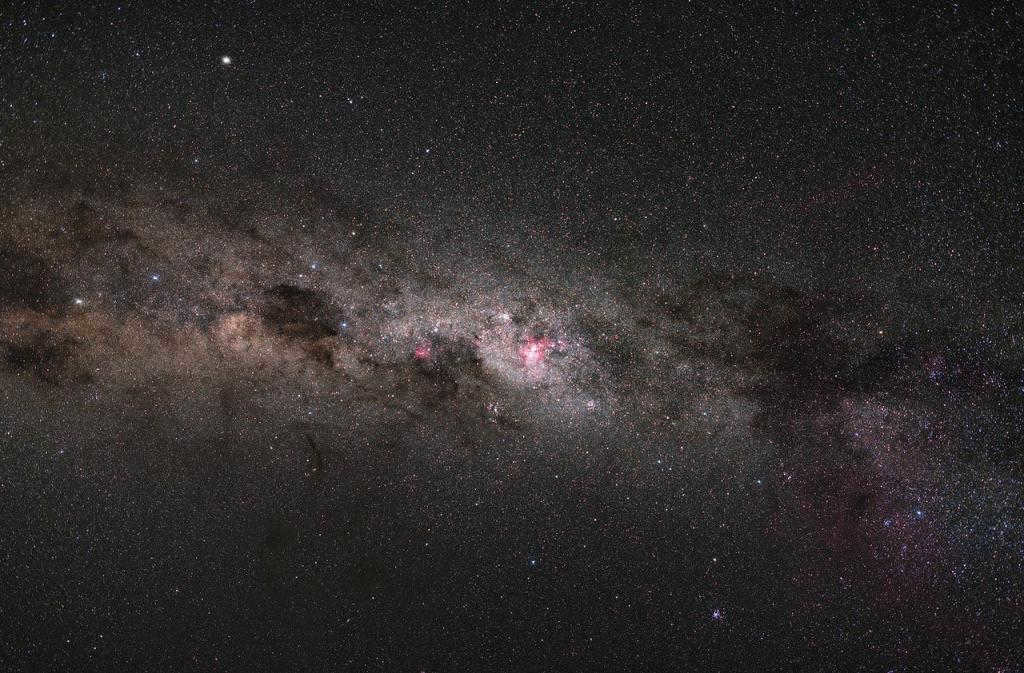
Velocity and Emissions
Physical Appearance
The Milky Way’s central region can be observed from Earth as a misty strip of bright light, approximately 30 degrees wide, curving across the nighttime sky. All of the individual stars that are visible to the naked eye at night are part of our galaxy, the Milky Way. This luminosity is a result of a concentration of unresolved stars and other celestial matter situated towards the galactic plane. Within this bright band, there are dark areas like the Great Rift and the Coalsack, where interstellar dust obstructs the light from distant stars. The portion of the sky that is concealed by the Milky Way is referred to as the Avoidance Zone.
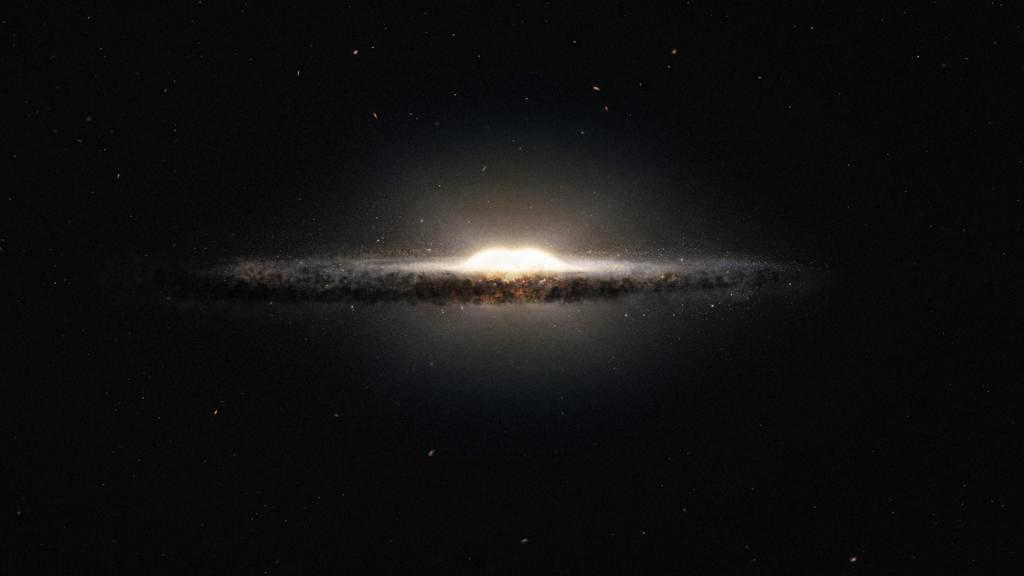

Luminosity

The dimensions of the Milky Way galaxy
The Milky Way is the second largest galaxy in the Local Group, with a stellar disk that spans approximately 100,000 light-years (30 kiloparsecs) in width and has an average thickness of around 1,000 light-years (0.3 kiloparsecs). The ring-shaped cluster of stars encircling the Milky Way could potentially be a part of the galaxy itself, moving up and down in relation to the galactic plane. If this is the case, it would indicate a diameter of 150,000-180,000 light-years (46-55 kiloparsecs).
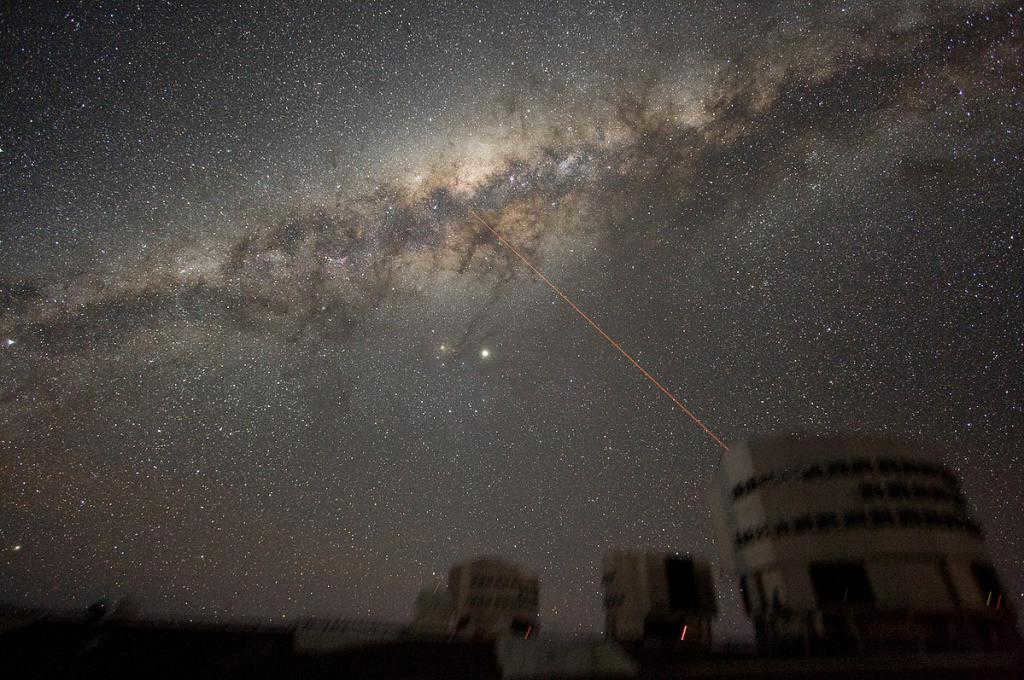
Mysterious Substance in the Milky Way
A significant portion of the Milky Way is composed of a mysterious substance known as dark matter, which cannot be seen or detected directly but exerts gravitational influence on regular matter. This enigmatic dark matter forms a halo that is evenly distributed throughout the galaxy at distances exceeding one hundred kilometers (kpc) from the center. Various mathematical models of our galaxy indicate that the mass of dark matter ranges from 1 to 1.5 × 1012 M☉. Recent research findings have revealed an expanded range of mass estimates, reaching as high as 4.5×1012 M☉, with a dimensionality measurement of 8×1011 M☉.
Gas in Outer Space
The collective weight of all the stars in the Milky Way ranges from 4.6×1010 M☉ to 6.43×1010 M☉. Alongside these stars, there is also interstellar gas composed of 90% hydrogen and 10% helium, with two-thirds of the hydrogen existing in its atomic state and the remaining third as molecular hydrogen. The mass of this gas equates to 10% or 15% of the overall mass of the galaxy’s stars. Another 1% of the total weight is accounted for by interstellar dust.
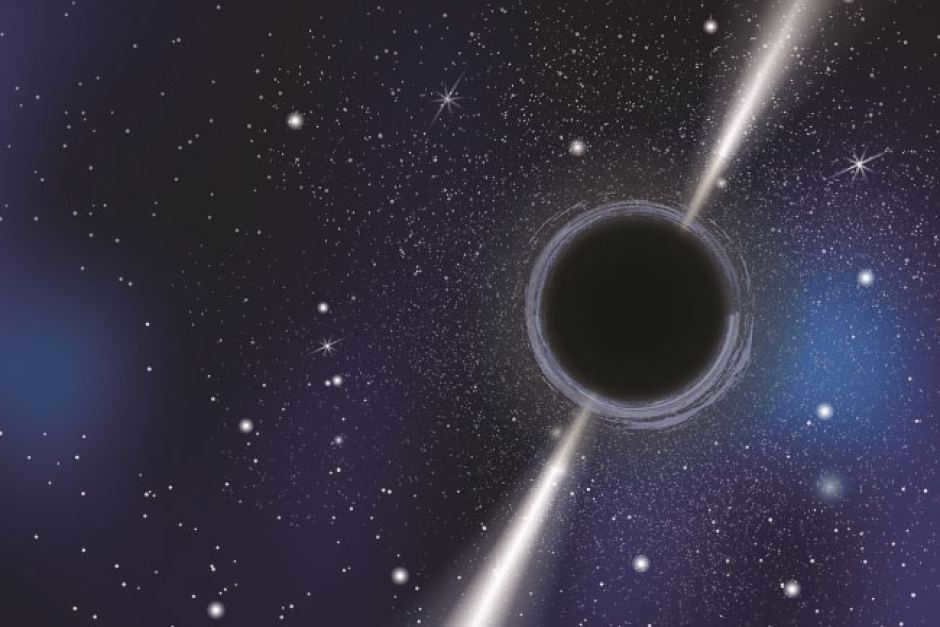
Understanding the composition and dimensions of our galaxy
The Milky Way is home to a staggering number of stars and planets. The estimated range is between 200 and 400 billion stars, with at least 100 billion planets. However, this number may not be entirely accurate due to the challenges of detecting very low-mass stars, especially those that are farther than 300 light-years away from the Sun. In comparison, our neighboring Andromeda Galaxy is even more massive, containing approximately a trillion stars. This means that Andromeda is larger than our own galaxy. Additionally, the Milky Way likely harbors around ten billion white dwarfs, billions of neutron stars, and a hundred million black holes. The space between stars is filled with a disk of gas and dust known as the interstellar medium. This disk has a radial extent similar to that of the stars, while the thickness of the gas layer can vary from hundreds to thousands of light-years, depending on the temperature of the gas.
The Milky Way is made up of a cylindrical core area encircled by a disk containing gas, dust, and stars. The mass distribution within the Milky Way is very similar to the Sbc category in the Hubble classification, which is characteristic of spiral galaxies with arms that are relatively loosely spread out. In the 1960s, astronomers first started to suspect that the Milky Way was a barred spiral galaxy rather than a regular spiral galaxy. This suspicion was later confirmed by observations made by the Spitzer Space Telescope in 2005, which revealed that the central bar of the Milky Way was larger than previously believed.
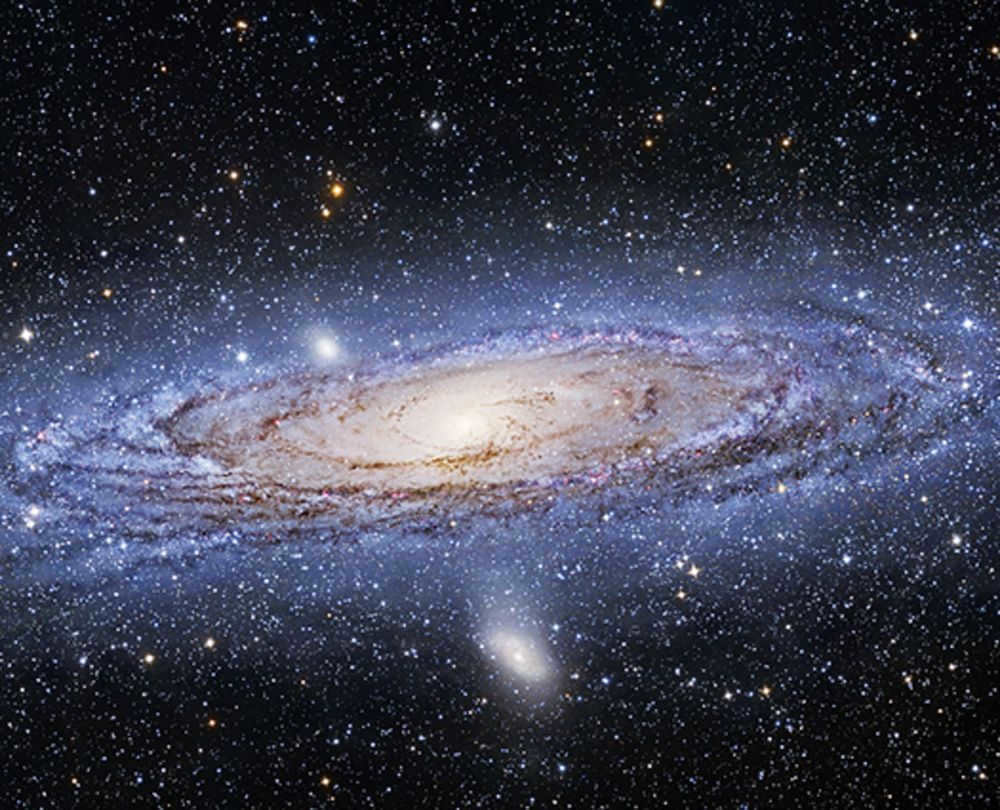
The representation of the size of our galaxy can vary. The Milky Way’s disk of stars does not have a sharp boundary where there are no stars beyond it. Instead, the density of stars decreases as you move away from the center of the galaxy. It is not fully understood why, but beyond a radius of approximately 40,000 ly from the center, the number of stars per cubic parsec decreases much more rapidly. Surrounding the galactic disk is a spherical halo made up of stars and globular clusters, which extends even further out. However, the size of this halo is limited by the orbits of the Milky Way’s two satellites, the Large and Small Magellanic Clouds. The closest of these satellites is approximately 180,000 ly away from the Galactic Center. Objects in the halo that are at this distance or farther away are likely to have their orbits disrupted by the Magellanic Clouds. As a result, these objects are likely to be expelled from the vicinity of the Milky Way.
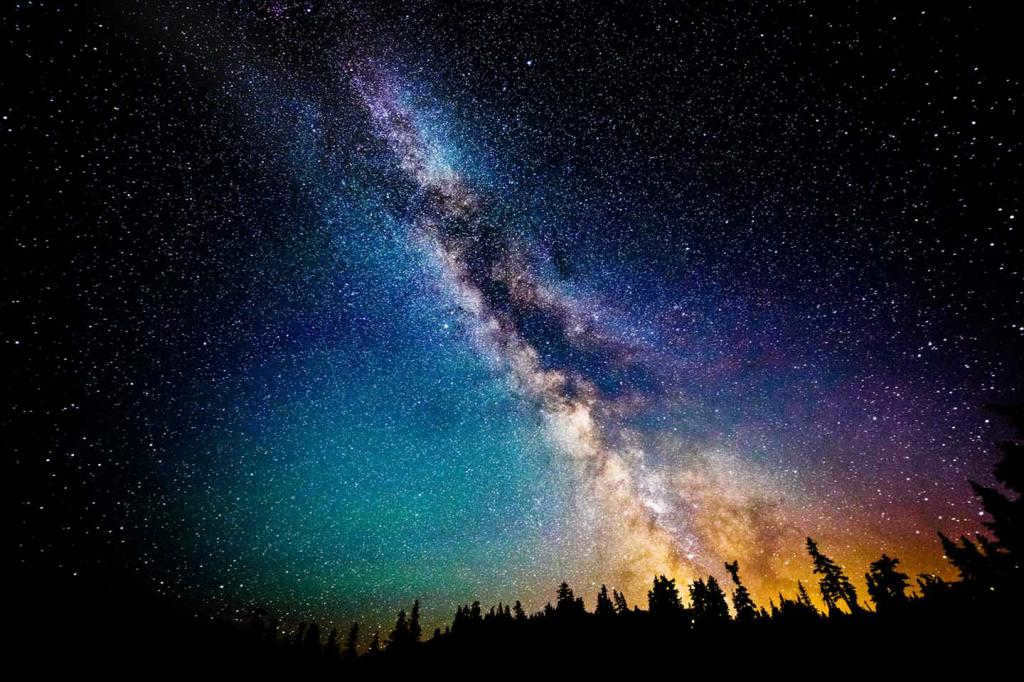
Star systems and autonomous planets
The size of the Milky Way encompasses the size of galaxies in general. The data from gravitational microlensing and planetary transit observations demonstrate that there are an equal number of planets orbiting stars as there are stars themselves within the Milky Way. Additionally, microlensing measurements suggest that there are more autonomous planets not bound to their host stars than there are stars. According to the Meilin Way, each star is accompanied by at least one planet, resulting in an estimated 100-400 billion planets.
Galaxies are vast celestial systems consisting of dust, gas, and numerous stars. Their sheer number is incalculable, as there exist a staggering 100 billion of them in the observable universe alone.
While certain galaxies bear a striking resemblance to our own Milky Way, others exhibit entirely unique characteristics.
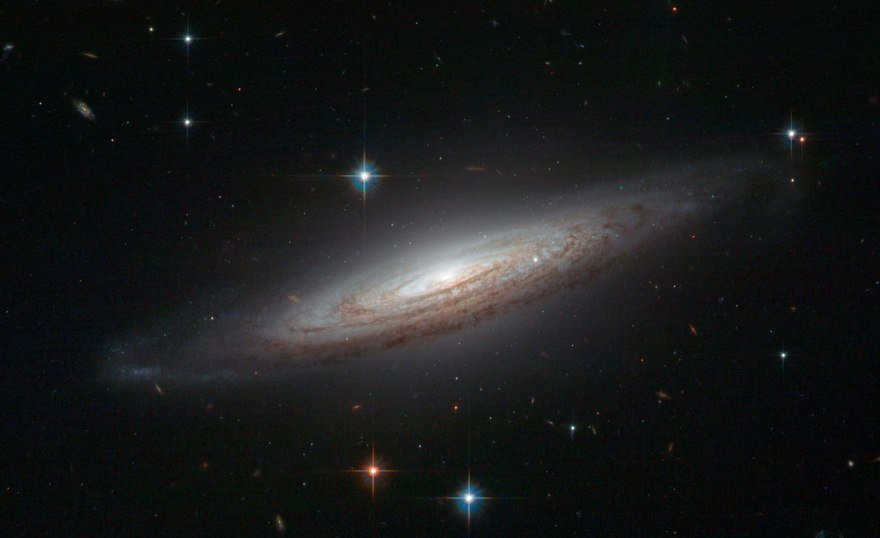
The formation and evolution of galaxies have not been fully comprehended by scientists due to the early occurrence of the initial stages. The age of the oldest galaxies almost matches the age of the universe, which is estimated to be around 10-13 billion years. To obtain more fascinating and valuable insights about the classification and age of galaxies, you can watch the informative video provided.
The Milky Way Galaxy
Our galactic home is a magnificent spiral-shaped galaxy that spans a distance of 100,000 light-years. At its core, a disk-shaped nucleus extends outward for 30,000 light-years and hosts a vast array of ancient stars as well as a mysterious black hole. Among the Milky Way’s spiral arms, our solar system resides in the Orion arm, positioned approximately 30,000 light-years away from the galactic center.
As we journey through space, our solar system orbits around the galactic center of the Milky Way at an impressive velocity of 250 km/s. It takes a staggering 220 million years for our system to complete a single revolution around the galactic center.
Table of characteristics of the main types of galaxies
| Spheroidal component | Whole galaxy | Yes | Very faint |
| Stellar disk | None or weak | Main component | |
| Gas-dust disk | No | Yes | |
| Spiral branches | No or only near the core | Yes | No |
| Active nuclei | Occur | No | |
| Percentage of total number of galaxies | 20% | 55% | 5% |
Spiral galaxies can be classified into two types: those with a central bar of stars intersecting the center, and those without such a formation.
In elliptical galaxies, the oldest stars are located and there is insufficient dust and gas to generate young ones. They may have a circular, oval, or spiral-like shape, but lack arms.
Around a quarter of galaxies are classified as irregular galaxies. They are smaller than spiral galaxies and often have peculiar shapes. These shapes can be attributed to the formation of new stars or gravitational interactions with neighboring galaxies. One example of an irregular galaxy is the Magellanic Clouds.
There are also various subtypes of galaxies, such as Seyfertian galaxies (which have fast-moving spirals), bright elliptical supergiants (which absorb other galaxies), ring galaxies (which lack a nucleus), and others.
Categories of Galaxies
Spiral Galaxies
A spiral galaxy, such as the Milky Way, is characterized by a flat disk, a bulging center, and spiral arms. The disk of a spiral galaxy contains a concentration of stars, planets, dust, and gas that orbit around the central bulge. The rotational speed can reach up to 100 km/s, causing the matter in the disk to take on a spiral shape. Some spiral galaxies exhibit unique formations, which have led to their distinct names, like the Sombrero Galaxy.
Within the central bulge, older stars are more prevalent, while new stars continue to form within the spiral arms. Surrounding the disks of spiral galaxies are halos composed of enigmatic dark matter.
To discover more about spiral galaxies, we invite you to read our informative article.
Spiral galaxies in the Messier catalog
Jumper galaxies
We also have a dedicated article on spiral galaxies known as jumper galaxies.
Spiral galaxies with a junction in the Messier catalog
Elliptical galaxies
An elliptical galaxy is characterized by its elliptical shape. While most are round, some can be elongated like a cigar. These galaxies are home to a large number of old stars, approximately 1 trillion, but lack interstellar matter such as dust. The stars in elliptical galaxies are concentrated around a central point and move in random directions, resulting in the formation of very few new objects.
The best-known examples of elliptical galaxies are the giant ones, which can span up to 2 million light-years. However, there are also smaller versions called dwarf elliptical galaxies.
To learn more about elliptical galaxies, please read our article on the subject.
Elliptical galaxies in the Messier catalog
Irregular galaxies
An irregular galaxy is a type of galaxy that does not fit into the first two categories. These galaxies have an irregular shape or lack a specific form due to their interaction with other celestial objects.
Learn more about irregular galaxies in our informative article.
The well-known irregular galaxies include:
The irregular galaxies found in the Messier catalog
Here is a compilation of less familiar galaxies:
Clusters of galaxies
Galaxies can exist independently or in pairs. However, in most instances, they form part of extensive associations known as groups, clusters, and superclusters. These entities interact and merge, eventually becoming singular galaxies. This process causes gases to flow towards the center of the galaxy, resulting in the initiation of star formation.
It is hypothesized that the Milky Way will eventually merge with the Andromeda galaxy, situated 2 million light-years away and observable from the northern hemisphere of Earth. These are all stages of galactic evolution, with irregular galaxies transforming into one of the various shapes and spiral galaxies transitioning into elliptical forms.
Scientists hypothesize that galaxies emerged shortly after the Big Bang, which occurred approximately 10-20 billion years ago, resulting in the creation of the universe. In the initial moments following the Big Bang, gas clouds began to combine and collapse under the influence of gravity, eventually forming the building blocks of galaxies.
While there is general consensus on the existence of galaxies in the early universe, there are differing opinions on how they originated and where the process began. Some researchers propose that the initial stage involved the merging of star clusters, comprised of millions of stars. On the other hand, others argue that galaxies existed from the very beginning and that stars subsequently merged into clusters. The video below provides further insight into the process of galactic structures merging and absorbing one another.
Active galaxies
An active galaxy is a special type of galaxy that releases a significantly greater amount of energy compared to a typical galaxy. While the Milky Way is considered to be relatively stable, active galaxies emit approximately 100 times more energy. This heightened energy release is a result of explosive events occurring in the galaxy’s nucleus, and it manifests in the form of radio waves. Active galaxies come in various forms and classifications.
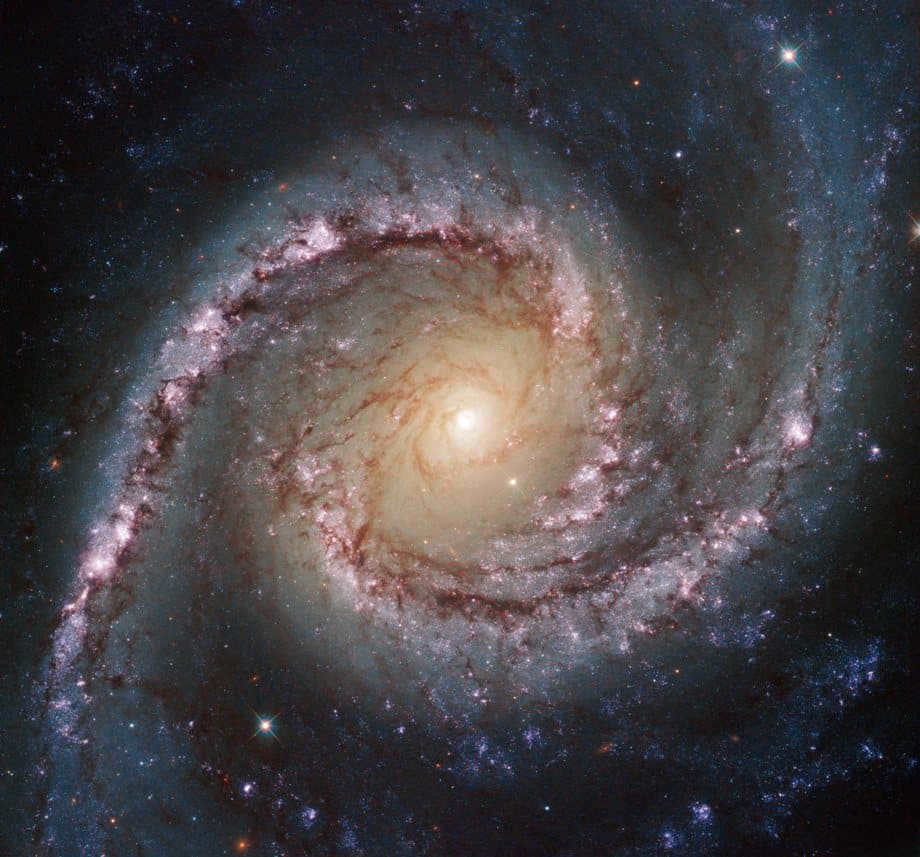
The spiral galaxy NGC 1566 provides a typical example of a Seyfert galaxy
Seyfert galaxies bear a resemblance to spiral galaxies, but with a nucleus that exhibits high levels of activity. Of particular interest are quasars, which have the ability to emit as much energy in a single second as the Sun does throughout its entire lifetime. These objects resemble stars and are considered to be the most energetic entities in existence. Many scientists speculate that quasars represent the active nuclei of distant galaxies during their early stages of evolution. The light emitted from these objects has been traveling through space for billions of years and may even originate from the very beginning of the universe.
So how did we come to understand our galaxy? The Milky Way was originally observed by ancient people as a streak of light in the sky. However, it wasn’t until the late 1500s when Galileo Galilei used a telescope to study the stars that we realized the Milky Way was actually made up of many individual objects. Then, in 1755, Immanuel Kant proposed the idea that our galaxy was a lenticular star band and that there were countless others like it in the Universe.
Over the years, scientists continued to study the galaxy and learn more about it. However, they still believed that the Sun was at the center of the galaxy. It wasn’t until 1918 when Harlow Shapley discovered that we were actually located on the outskirts of the galaxy, changing our understanding of its structure entirely.
Hubble, galaxies, and the expansion of the Universe
Edwin Hubble deserves much recognition for his groundbreaking work in 1924, which demonstrated that our galaxy is just one of many. Through the use of his impressive 100-inch telescope, he made the remarkable discovery that a cluster of stars previously believed to be part of the Milky Way were, in fact, the Andromeda galaxy situated 2.2 million light-years away. It was in 1927 that Jan Oort further expanded our understanding by proving that galaxies undergo rotations around their central points.
